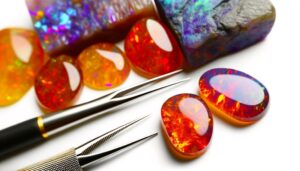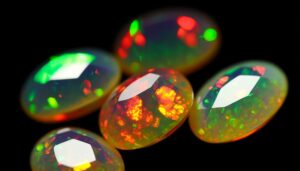10 Key Differences: Citrine vs Fire Opal
Citrine, primarily composed of silicon dioxide (SiO2) with iron impurities, exhibits a hardness of 7 on the Mohs scale and displays pale yellow to deep amber hues. It forms in igneous and metamorphic rocks, particularly in Brazil.
Fire opal, a hydrated silica (SiO2·nH2O) with a lower hardness of 5.5-6.5, presents vibrant yellows, oranges, and reds due to its silica sphere structure. Originating from volcanic regions like Mexico, it's more prone to fractures.
Citrine's durability makes it suitable for daily wear, while fire opal's play-of-color attracts collectors. There's a lot more about their unique properties and historical significance.
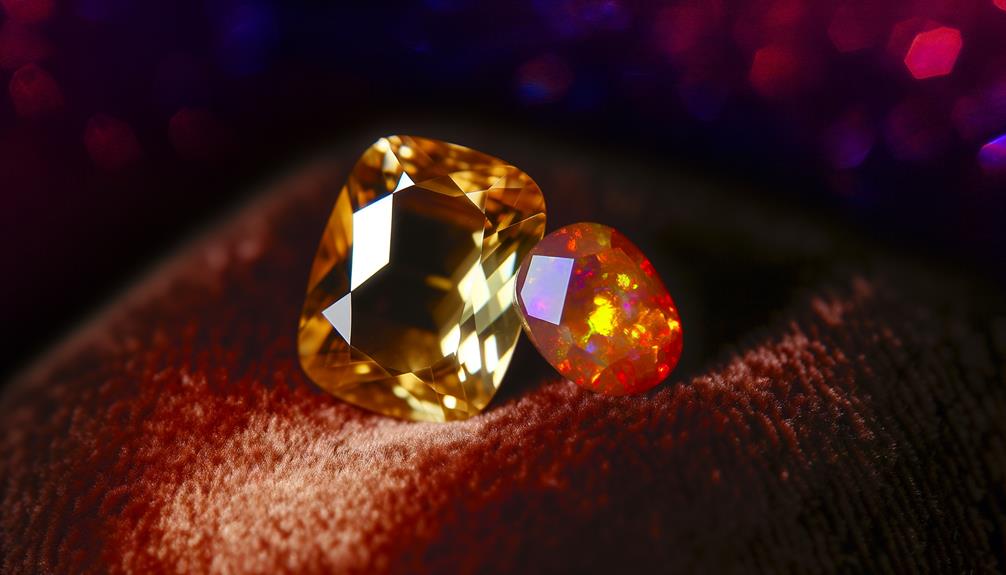
Key Takeaways
- Color and Luster: Citrine ranges from pale yellow to deep amber with a vitreous luster, while fire opal displays warm tones with a waxy to resinous luster.
- Hardness and Durability: Citrine is more durable with a Mohs hardness of 7, making it suitable for everyday wear, compared to fire opal's 5.5-6.5 rating.
- Origins: Citrine is primarily sourced from Brazil, whereas fire opal is predominantly found in Mexico.
- Chemical Composition: Citrine is crystalline silicon dioxide (SiO2) with iron impurities, whereas fire opal is hydrated silica (SiO2·nH2O).
- Price and Value: Fire opal, especially with intense colors, is rarer and more expensive than citrine, which increases in value with deeper hues.
Origins and Sources

Citrine and fire opal each have distinct geological origins and are sourced from specific regions around the world. Citrine, a variety of quartz, forms in igneous and metamorphic rocks, primarily through hydrothermal processes. Brazil is the dominant supplier, with notable deposits also found in Madagascar and Russia.
Fire opal, on the other hand, is a hydrated amorphous form of silica, often forming in volcanic regions. It requires rapid cooling of silica-rich water within lava flows. Major sources include Mexico, which produces the most vibrant specimens, as well as Honduras and the United States.
Understanding these origins helps you appreciate the unique conditions under which each gemstone forms, offering insights into their distinct characteristics and the geological diversity of their respective locales.
Color and Appearance
Understanding the geological origins of citrine and fire opal provides a foundation to explore their distinct color and appearance, revealing the unique visual properties that make each gemstone highly sought after.
Citrine typically exhibits a range of hues from pale yellow to deep amber, often with a vitreous luster, resulting from trace amounts of iron within the quartz structure.
In contrast, fire opal captivates with its vibrant play-of-color, displaying warm tones from yellow to red, and even orange. This phenomenon, known as opalescence, is due to submicroscopic silica spheres causing light diffraction. Fire opals often possess a waxy to resinous luster, enhancing their fiery brilliance.
These characteristics greatly influence each stone's desirability and market value.
Chemical Composition
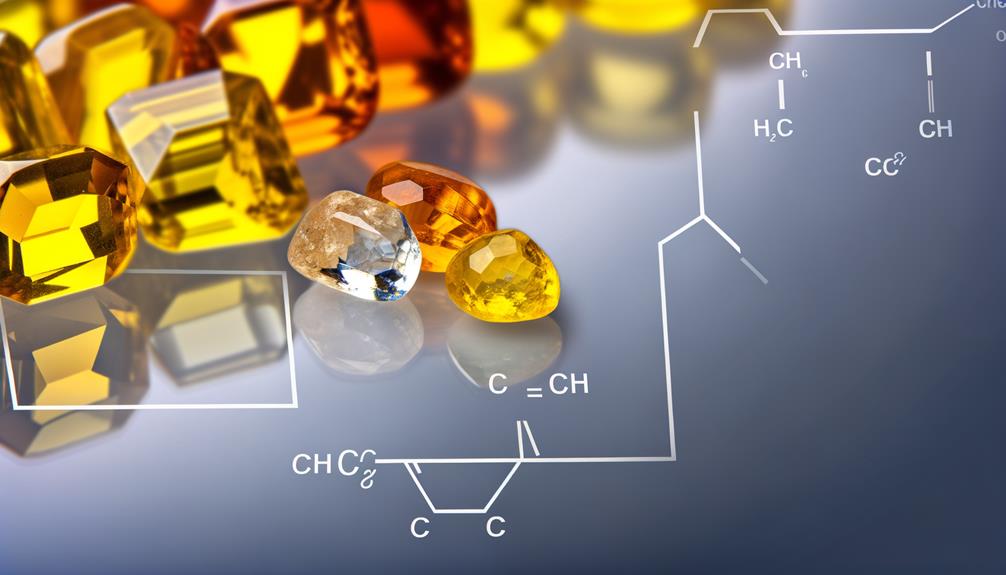
When comparing the chemical compositions of citrine and fire opal, you'll find distinct differences. Citrine primarily consists of silicon dioxide (SiO2) with trace impurities like iron giving it its yellow hue.
On the other hand, fire opal is a hydrated form of silica (SiO2·nH2O) with varying water content, contributing to its unique play of colors.
Citrine's Chemical Formula
The chemical formula for citrine, a variety of quartz, is SiO₂, indicating that it's mainly composed of silicon dioxide. In this structure, each silicon atom is covalently bonded to four oxygen atoms, forming a tetrahedral network that extends throughout the crystal.
You'll find that trace amounts of iron within the crystal lattice give citrine its distinctive yellow to orange coloration. These iron impurities typically exist in the form of Fe³⁺ ions. The presence of these ions causes specific wavelengths of light to be absorbed, producing the gem's characteristic hue.
Understanding the chemical composition of citrine helps you appreciate its physical properties such as hardness, stability, and refractive index, making it a popular choice in jewelry and ornamental applications.
Fire Opal's Composition
While citrine's allure comes from its iron-induced hues, fire opal enchants with its vibrant play of colors, which stems from its unique chemical composition of hydrated silica, SiO₂·nH₂O.
You'll find that fire opal consists primarily of silica spheres arranged in a regular pattern, interspersed with water molecules. The presence of water, typically ranging from 3% to 10%, influences its transparency and color intensity.
Unlike crystalline quartz, fire opal's amorphous structure lacks a defined lattice, contributing to its distinct optical phenomena. The diffraction of light through these microscopic silica spheres generates the mesmerizing flashes of red, orange, yellow, and green.
Understanding this composition helps explain why fire opal possesses its signature fiery brilliance and captivating play-of-color.
Elemental Differences
Citrine and fire opal differ fundamentally in their chemical compositions, with citrine being a variety of crystalline quartz (SiO₂) and fire opal comprising an amorphous arrangement of hydrated silica (SiO₂·nH₂O).
In citrine, the silicon dioxide forms a well-ordered, repeating crystal lattice, contributing to its transparency and hardness. Conversely, fire opal lacks a crystalline structure, containing water molecules within its silica network, which gives it a unique play-of-color and lower hardness.
Citrine's chemical stability and structured form make it less susceptible to physical and chemical weathering. Fire opal's amorphous structure, on the other hand, can lead to dehydration and subsequent cracking.
Understanding these differences helps you appreciate their distinct physical and aesthetic properties.
Hardness and Durability
When evaluating the hardness and durability of gemstones, you'll find that citrine, with a Mohs hardness rating of 7, is much more resistant to scratching than fire opal, which typically falls between 5.5 and 6.5.
This difference in hardness means citrine is better suited for everyday wear, as it can withstand more physical impact and abrasion. Fire opal's relatively lower hardness makes it more susceptible to damage and less ideal for high-contact jewelry pieces like rings.
Additionally, citrine's crystalline structure contributes to its durability, whereas fire opal's amorphous structure makes it more prone to fractures and chips.
Hence, if you're looking for a gemstone with greater longevity and less maintenance, citrine would be the superior choice.
Historical Significance
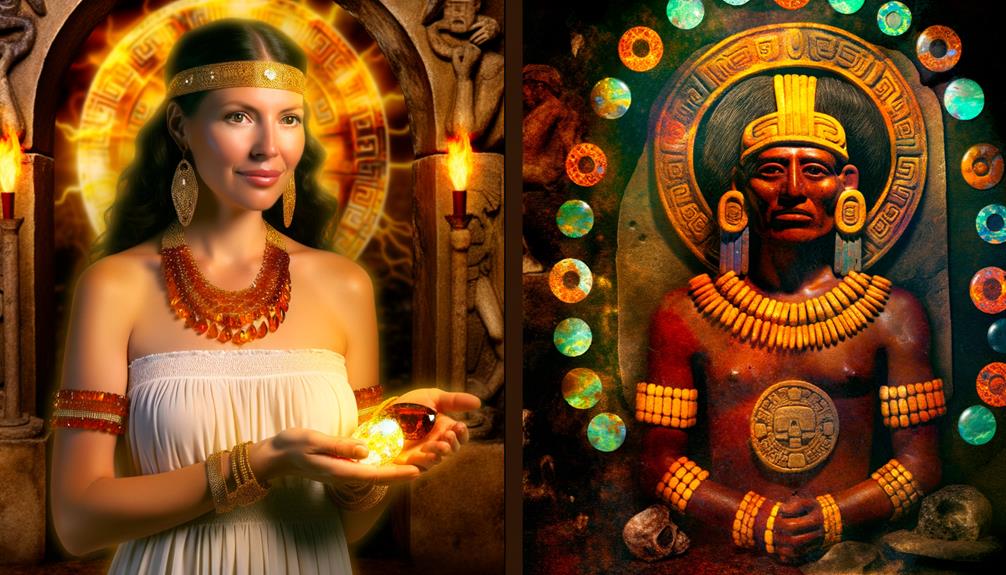
Throughout history, both citrine and fire opal have held significant cultural and mystical importance in various civilizations, often being utilized in rituals, adornments, and as symbols of specific virtues. In Ancient Greece, citrine was associated with the sun and believed to carry the power to dispel negativity. Meanwhile, the Aztecs prized fire opal, using it in mosaics and rituals to invoke divine favor.
| Civilization | Gemstone | Usage | Belief |
|---|---|---|---|
| Ancient Greece | Citrine | Jewelry, amulets | Dispel negativity, solar energy |
| Aztecs | Fire Opal | Mosaics, ritualistic items | Divine favor, spiritual communication |
| Roman Empire | Citrine | Signet rings | Protection and prosperity |
| Native Americans | Fire Opal | Ceremonial artifacts | Healing and prophecy |
This historical significance underscores the enduring allure and multifaceted applications of these gemstones.
Symbolism and Meaning
How do the distinct characteristics of citrine and fire opal encapsulate their respective symbolic meanings and cultural significance?
Citrine, with its vibrant yellow to amber hues, symbolizes prosperity, clarity, and energy. Its crystalline structure and color are associated with the sun, invoking warmth and positivity. Culturally, it's often linked to wealth and success, earning the moniker 'Merchant's Stone.'
Fire opal, characterized by its fiery play-of-color, represents passion, transformation, and creativity. This opal's internal diffraction of light produces a mesmerizing effect that symbolizes the inner flame and emotional intensity. Historically, it's been revered for its supposed ability to stimulate change and ignite one's inner fire.
Both stones, though geologically distinct, encapsulate profound symbolic meanings rooted in their physical properties.
Common Uses
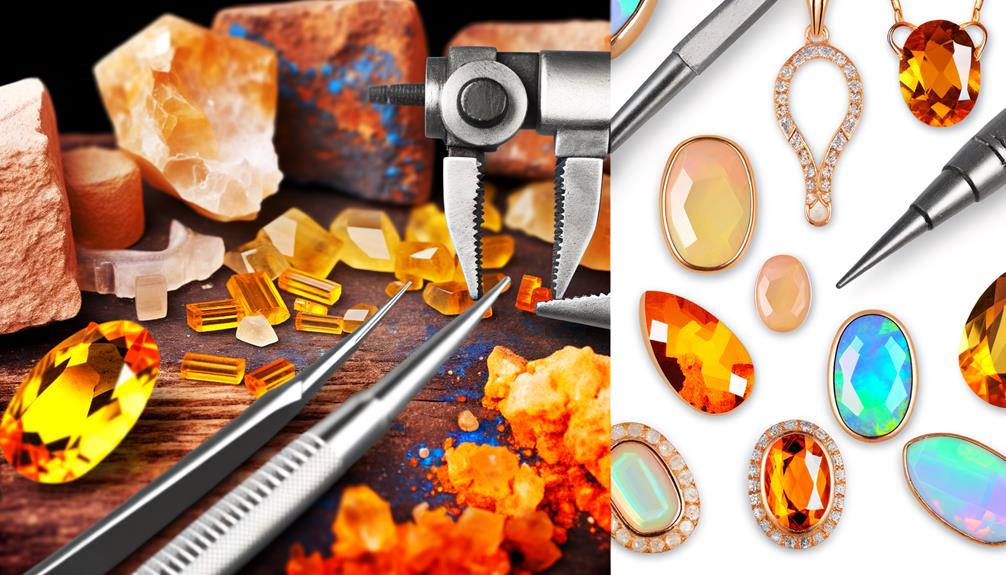
You'll find that both citrine and fire opal serve multiple functions, from jewelry and accessories to spiritual and healing practices.
In jewelry, citrine's durability and fire opal's vibrant colors make them popular choices for various adornments.
Additionally, both stones are utilized in decorative and ornamental contexts, enhancing aesthetic appeal through their unique visual properties.
Jewelry and Accessories
In jewelry and accessories, citrine and fire opal are frequently chosen for their unique optical properties and vibrant hues, making them popular in various settings such as rings, earrings, and pendants.
Citrine's hexagonal crystal system and vitreous luster offer a resilient and bright yellow to amber hue, suitable for daily wear.
Fire opal, with its amorphous structure and play-of-color phenomenon, provides an iridescent, fiery appearance that captivates in statement pieces.
You'll find that citrine's Mohs hardness of 7 makes it more durable than fire opal, which ranges from 5.5 to 6.5. This distinction affects your choice depending on the jewelry's intended use and wear frequency.
Understanding these properties helps you select the best gemstone for your needs.
Spiritual and Healing
Exploring the spiritual and healing properties of citrine and fire opal reveals their distinct roles in promoting emotional well-being and energy balance.
Citrine, often termed the 'Merchant's Stone,' is believed to enhance personal willpower, clear negative energies, and boost financial success. It's linked to the solar plexus chakra, fostering self-confidence and clarity of thought.
Fire opal, conversely, is associated with the sacral chakra, stimulating creativity, passion, and emotional expressiveness. Known for its vibrant, fiery hues, it's thought to release inhibitions and encourage spontaneous action.
Both gemstones are utilized in crystal healing practices, but their unique vibrational frequencies cater to different aspects of mental and emotional health, offering targeted support depending on your specific needs and goals.
Decorative and Ornamental
Citrine and fire opal are extensively used in jewelry design, with their distinct colors and refractive properties making them popular choices for rings, necklaces, and ornamental pieces. These gemstones are prized for their ability to enhance various aesthetics and settings.
Here are some common uses:
- Rings: Citrine's yellow hue and fire opal's fiery play-of-color are ideal for statement rings.
- Necklaces: Both stones add vibrant focal points to pendants and beaded designs.
- Earrings: Leveraging their refractive properties, these gems bring sparkle and life to earlobes.
- Brooches: Their unique colors make them perfect for eye-catching, decorative brooches.
Understanding the specific qualities of each stone can help you make informed choices when selecting ornamental pieces.
Famous Specimens
Among the most renowned specimens, the Smithsonian Institution's 'Carmen Lúcia Citrine' and the 'Burning Heart' Fire Opal stand out for their exceptional clarity and vivid color. The Carmen Lúcia Citrine weighs an impressive 20.10 carats, exhibiting a mesmerizing golden hue that exemplifies the finest quality of citrine. Its cut maximizes light dispersion, giving it remarkable brilliance.
In contrast, the 'Burning Heart' Fire Opal showcases an intense, fiery orange-red color, a characteristic hue of high-quality fire opals. Weighing 55.55 carats, this specimen's play-of-color phenomenon is particularly notable, with flashes of green and yellow visible under various lighting conditions.
Both gems epitomize the pinnacle of their respective categories, highlighting their distinctive optical properties and geological uniqueness.
Price and Value
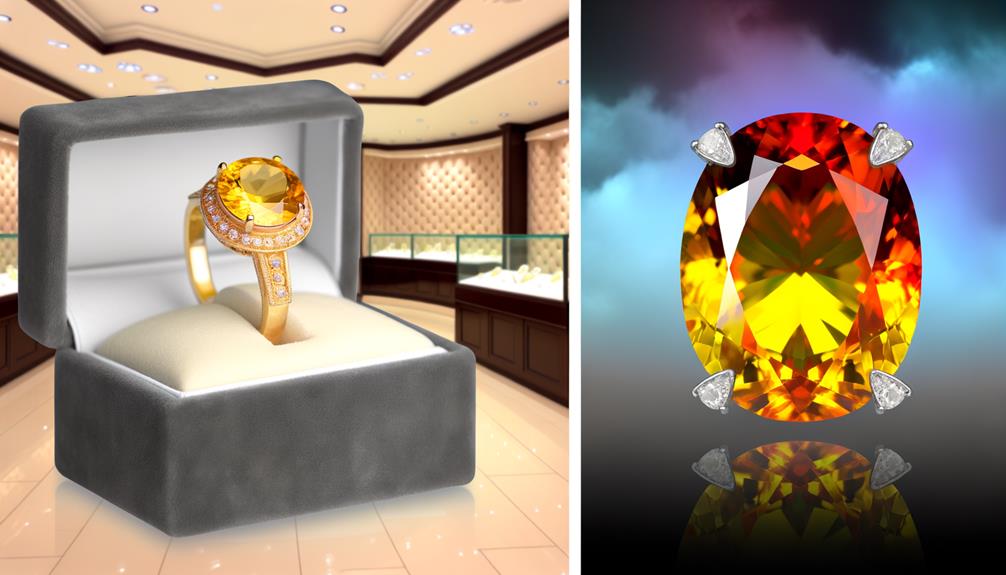
When evaluating the price and value of citrine and fire opal, factors such as color saturation, clarity, carat weight, and overall rarity play critical roles in determining their market worth. Understanding these variables helps you make an informed decision.
- Color Saturation:
Citrine's value increases with deeper, more vibrant hues, while fire opal commands higher prices for intense oranges and reds.
- Clarity:
Both gemstones are more valuable when free from inclusions, though fire opals may naturally contain more.
- Carat Weight:
Larger stones of both types generally have higher per-carat prices.
- Rarity:
High-quality fire opals are rarer than citrines, often making them more expensive.
Treatments and Enhancements
When considering citrine and fire opal, you'll find that treatments and enhancements play a significant role in their market availability and visual appeal.
Citrine often undergoes heat treatment to intensify its color, whereas fire opal is usually treated to improve its clarity and stability.
These processes impact both the gemstones' durability and their long-term maintenance requirements.
Common Enhancement Methods
Citrine and fire opal often undergo various treatments to enhance their color and clarity, with heating and dyeing being the most prevalent methods. Here's a detailed breakdown of common enhancement techniques:
- Heat Treatment: Applied to citrine to transform pale or smoky quartz into vibrant yellow hues.
- Dyeing: Used for fire opals to intensify or alter their natural colors, achieving more vivid appearances.
- Irradiation: A process occasionally employed on citrine to induce color changes before subsequent heating.
- Impregnation: Fire opals may be impregnated with oils or resins to improve stability and gloss.
Understanding these methods allows you to appreciate the scientific processes behind gemstone enhancement, ensuring a more informed choice when purchasing or appraising gems.
Heat Treatment Effects
How does heat treatment alter the molecular structure of citrine and fire opal, thereby enhancing their color and overall appeal?
In citrine, heat treatment often converts amethyst into citrine by rearranging iron impurities within the crystal lattice, resulting in the desirable yellow to orange hues.
Fire opal, on the other hand, undergoes thermal enhancement to improve its body color and transparency. The process can remove water content, reduce internal stress, and enhance the play-of-color by altering the arrangement of silica spheres.
Both treatments aim to optimize visual properties without compromising the gem's inherent characteristics. Understanding these molecular changes provides insight into why treated stones often command higher market value due to their improved aesthetic qualities.
Durability and Stability
Heat treatments and other enhancements impact the durability and stability of citrine and fire opal. These processes often make the gems more resistant to environmental stressors but occasionally introduce vulnerabilities.
Citrine, primarily heat-treated amethyst, gains increased color stability but may still fade under prolonged UV exposure. Heat Sensitivity: Citrine remains stable up to 500°C.
Fire opal, often treated to enhance color and clarity, can become more susceptible to crazing (fine surface cracks) due to these processes. Heat Sensitivity: Fire opal can crack under rapid temperature changes.
Consider the following aspects:
- UV Resistance: Citrine's color may fade under UV light, whereas fire opal's color is generally stable.
- Moisture Absorption: Fire opal is hygroscopic, absorbing water, which can cause instability.
- Hardness: Citrine ranks 7 on the Mohs scale, offering better scratch resistance than fire opal, which is softer at 5.5-6.5.
Care and Maintenance
Properly maintaining and caring for both citrine and fire opal guarantees their longevity and brilliance. For citrine, avoid exposure to extended sunlight as it can lead to color fading. Clean it using warm, soapy water and a gentle brush. Ultrasonic cleaners are usually safe, but refrain from steam cleaning.
Fire opal, being more fragile, requires more delicate care. Never use ultrasonic or steam cleaners. Instead, use lukewarm water, mild soap, and a soft cloth. Avoid abrupt changes in temperature, which can result in cracking.
Both stones should be stored separately in soft pouches to prevent any scratches. By following these guidelines, you'll ensure that your citrine and fire opal pieces retain their stunning appearance and structural integrity for years to come.
Birthstone Information
Understanding the unique characteristics of citrine and fire opal extends beyond care and maintenance; each stone also holds a significant place in the world of birthstones.
Citrine, the birthstone for November, symbolizes prosperity and joy due to its vibrant yellow-to-orange hue, attributed to trace amounts of iron.
Fire opal, associated with October, is known for its fiery play-of-color and represents passion and creativity, featuring a high water content influencing its translucence and color variations.
Here are four key points to contemplate:
- Citrine: November birthstone; promotes positivity.
- Fire Opal: October birthstone; enhances passion.
- Color Origin: Citrine's iron content vs. Fire Opal's water content.
- Symbolism: Citrine for joy and success, Fire Opal for creativity and passion.
Understanding these aspects enriches your appreciation of these gemstones.
Purchasing Tips
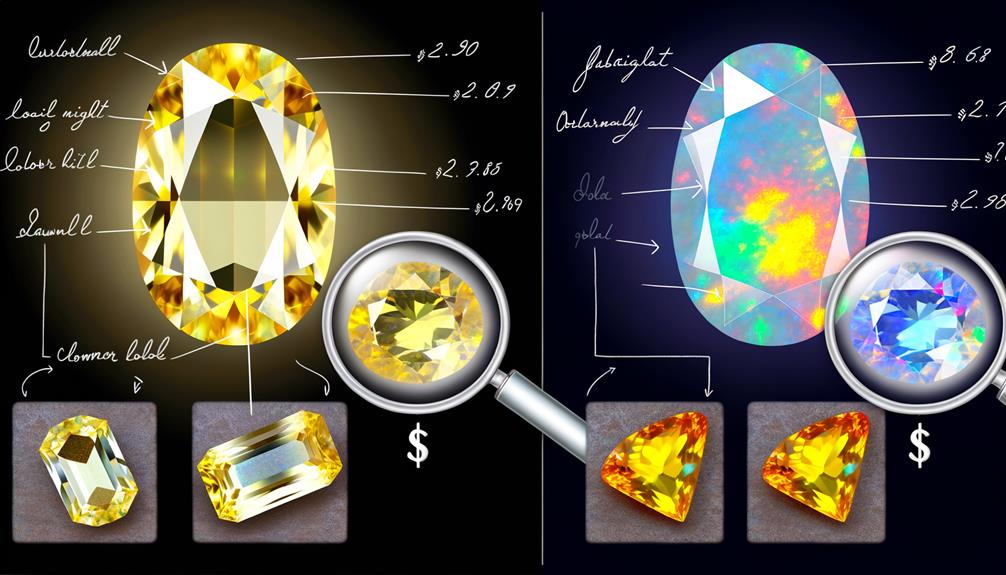
When purchasing citrine or fire opal, make sure you assess the stone's clarity, cut, and color to determine its quality and value. Clarity impacts transparency and brilliance. Look for minimal inclusions. The cut should enhance light reflection, maximizing sparkle. Color consistency is crucial; citrine ranges from pale yellow to deep amber, while fire opal varies from yellow to red. Use this table as a quick reference:
| Attribute | Citrine | Fire Opal |
|---|---|---|
| Clarity | Transparent, few inclusions | Slightly included, more visible inclusions |
| Cut | Faceted, well-polished | Often cabochon |
| Color | Yellow to amber | Yellow to red |
| Origin | Brazil, Madagascar | Mexico, Australia |
| Price Range | Moderate | Variable, higher for intense colors |
Conclusion
In choosing between citrine and fire opal, consider their unique origins, distinct colors, and specific chemical compositions.
With citrine's greater hardness and fire opal's vibrant play of color, both offer unique advantages. Treatments and proper care are essential to maintain their beauty.
As birthstones, they carry historical and personal significance. So, which gemstone aligns with your aesthetic and emotional needs? Ultimately, your decision should reflect both scientific understanding and personal connection.

